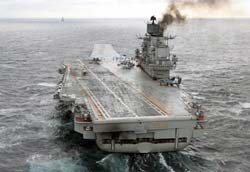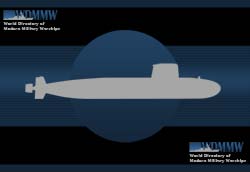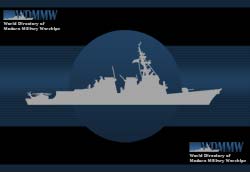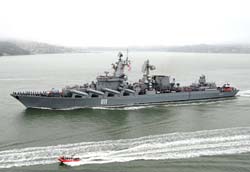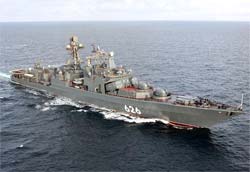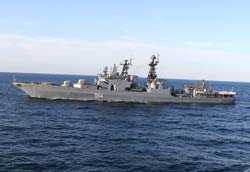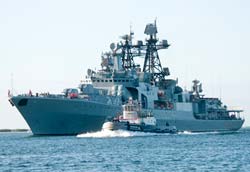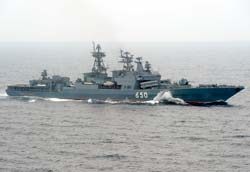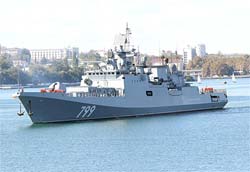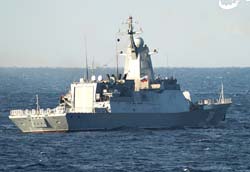The modern Russian Navy keeps a solid focus on its coastline and underwater activities with a noticeable commitment to corvettes (31.2%), submarines (21.8%), and mine/countermine warfare (18.0%). The rest of the fleet is relatively balanced, covering such types as aircraft carrier, cruiser/battlecruiser, destroyer, frigate, offshore patrol, and amphibious assault support. The aircraft carrier fleet is made up of a sole unit, the aging Kuznetsov, which is inherently limited on the modern battlefield and ungoing refit. Likewise, the sizeable submarine fleet (58 units) leans heavily on units reaching, or well-past, their optimal operating ages. The cruiser force is also an aging group with the youngest example entering its 23rd year-of-service. The destroyer force sees the same problem, units aging closer to 30 years. Conversely, the frigate force (11 units) has been addressed with new additions. By and large, the corvette fleet makes up the largest part of the Russian surface combatant force, numbering 83 units with more on the way. These, too, are an aging group but bouyed by new arrivals. The mine warfare division is primarily aging Soviet Cold War-era instruments as is the bulk of the amphibious assault/support force. Nevertheless, some 80 new hulls are to make their way into service in the coming year, forcing a modernization of key parts of the Russian fleet.
The following represents an overview of the modern naval fighting capabilities of the Russian Navy (2024). The service currently counts 265 total units in its active naval inventory. This total includes frontline commissioned vessels but excludes smaller patrol vessels, auxiliary / survey ships, replenishment, and historical ceremonial types. The WDMMW review takes into account specific categories of warships covering attack, defense, and general support designs. Inventory numbers and related unit types are provided as-is and derived from publically-available information / sources. "On Order" totals found at the bottom of this article are related to any future hulls currently under procurement/construction though said hulls may not be delivered for service in the current year for various reasons.
Updated: 03/08/2024 | © www.WDMMW.org
Aircraft Carriers (1)
Hulls defined as those designed primarily to launch, retreive, and maintain fixed-wing and/or rotary-wing aircraft; nuclear- or conventionally-powered.
NOTES: Kuznetsov is undergoing refit to extend her sailing career.
Submarines (58)
Hulls developed for undersea/submersible operation; nuclear-powered or conventionally-powered.
NOTES: Yekaterinburg (K-84) is set to be decommissioned in 2022.
Cruisers (4)
Hulls classified as cruiser types, typically dimensionally larger than Destroyers.
NOTES: Admiral Nakhimov is undergoing refit. Moskva was announced LOST-IN-ACTION after a Ukrainian missile attack in April 2022.
Destroyers (12)
Multi-mission hulls developed for Blue Water environment; operating independently or as part of the main surface fleet.
Frigates (11)
Hulls defined as dimensionally smaller than Destroyers, though larger than corvettes, having Blue Water capabilities.
Corvettes (83)
Hulls defined as dimensionally smaller than frigates but larger than OPVs, capable of operating independently or as part of the main fighting fleet.
NOTES: The Karakurt-class missile corvette Askold, in sea trials, was reported a total loss following a Ukrainian missile strike against Russian-held Crimea.
Mine Warfare (48)
Hulls outfitted for the purpose of mine countermeasures/countermine warfare.
Offshore Patrol Vessels (27)
Hulls defined as OPVs and outfitted for the purpose of close-to-shore defense / deterrence.
NOTES: Sergey Kotov, part of the Project 22160 patrol boat class, was sunk by Ukrainian naval drones in March of 2024.
Amphibious Assault (21)
Hulls designed specifically for the support of amphibious-minded, offshore / close-to-shore operations.
On Order (81)
Hulls set to be delivered in the current procurement year or in subsequent year(s).
On Order Commitment: 81 Units
©2024 • Content ©2021-2024 WDMMW.org • All Rights Reserved. The WDMMW.org logo, its written content, and watermarked photography are unique to this website (unless where indicated) and is protected by all applicable domestic and international intellectual property laws. This resource uses publically-released imagery from the US DoD, the Russian MoD, the Chinese MoD, the Royal Australian Navy, the Royal Canadian Navy and others as well as manufacturer marketing photos - no endorsement of this site by these parties/entities should be implied. Illustrations of products are copyright WDMMW.org (and are marked as such) and not for reuse/republication. Information found across this site, verified through publicly available sources, is assumed to be accurate at the time of publication.Material presented throughout this website is for historical and entertainment value only and should not to be construed as usable for hardware restoration, maintenance, or general operation. Part of a network of sites that includes , , and . WDMMW.org is a sister site to . No A.I. was used in the generation of this content.
©2024 www.WDMMW.org • All Rights Reserved • Content ©2021-2024 (3yrs)






